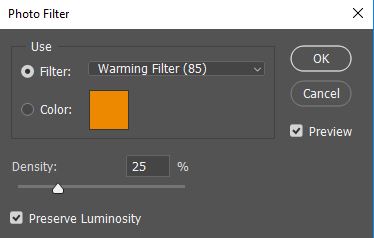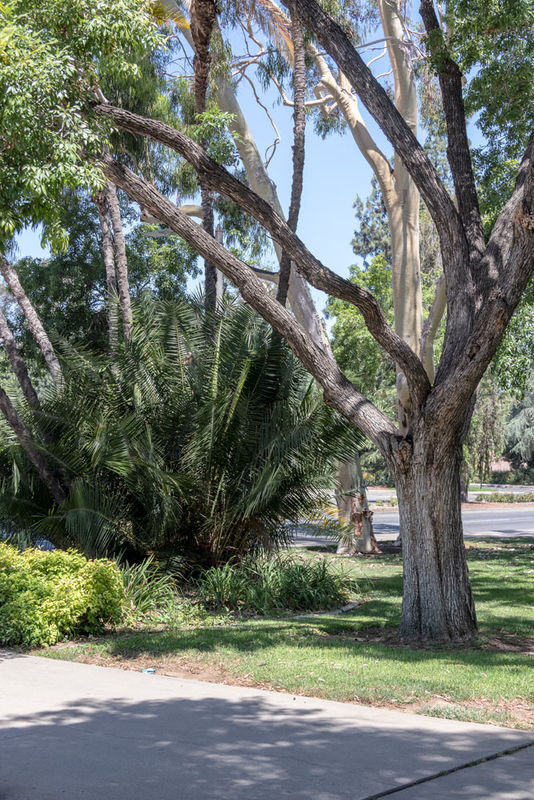plLens filter software
Jul 13, 2018 21:48:20 #
icatDoes anyone know if there are any good software programs that replicate lens filters?...Julian
Jul 13, 2018 22:10:49 #
julian.gang wrote:
icatDoes anyone know if there are any good software programs that replicate lens filters?...Julian
Photoshop can do it. Go to Image/Adjustments/Photo Filter and you can pick from a list of filters or design your own.

Jul 13, 2018 22:39:53 #
However, be aware the only filters that cannot be replicated in software during post processing are polarizing and neutral density.
Jul 13, 2018 22:48:23 #
Untrue. Adobe Camera Raw now has a dehaze filter that emulates a CP filter. The ND filter in ACR now can isolate the sky for a separate adjustment of it.
f8lee wrote:
However, be aware the only filters that cannot be replicated in software during post processing are polarizing and neutral density.
Jul 13, 2018 23:15:20 #
anotherview wrote:
Untrue. Adobe Camera Raw now has a dehaze filter that emulates a CP filter. The ND filter in ACR now can isolate the sky for a separate adjustment of it.
The dehaze filter is pretty neat, but it doesn’t really mimic the effects of a polarizer. Does nothing with reflections or speculation highlights.
Andy
Jul 14, 2018 03:50:08 #
anotherview wrote:
Untrue. Adobe Camera Raw now has a dehaze filter that emulates a CP filter. The ND filter in ACR now can isolate the sky for a separate adjustment of it.
Evidently you are unfamiliar with how a polarizing filter can deepen the blue of the sky (at the proper camera/sun orientation) and reduce glare, neither of which the dehaze filter (with which I am quite familiar) can do.
Nor can post processing help if you want to, say, slow the shutter speed (to achieve motion blur, perhaps of moving water) or use a wider aperture (to get shallower DOF). Your comment implies a use of a graded ND filter, but that is not fo what i spake.
Jul 14, 2018 07:44:43 #
Good morning. I know how a CP filter works and its effects.
Processing the sky in Adobe Camera Raw can include the Dehaze Filter and the new version of the Graduated Filter.
If need be, in the full Photoshop CC, a user can go the Menu Bar > Select > Color Range to select only the sky area, for further processing, to gain verisimilitude in that area.
With the sky area selected, the user can also apply the Photo Filter Adjustment to blue up the sky to eye.
These four software adjustments have made the CP Filter and the GND Filter near obsolete -- assuming a good exposure of the sky area in the camera.
But yes, if the subject contains a lot of glare off, say, plantlife or water, then a CP Filter may prove indispensable. The GND Filter, however, a user may leave at home given the software manipulations available now.
This approach does rely somewhat on the low-noise images from newer cameras, because properly exposing the sky will render the foreground underexposed. This fact requires lifting the exposure of the foreground in the software (ACR and PCC). I do this manipulation all the time and with success.
Processing the sky in Adobe Camera Raw can include the Dehaze Filter and the new version of the Graduated Filter.
If need be, in the full Photoshop CC, a user can go the Menu Bar > Select > Color Range to select only the sky area, for further processing, to gain verisimilitude in that area.
With the sky area selected, the user can also apply the Photo Filter Adjustment to blue up the sky to eye.
These four software adjustments have made the CP Filter and the GND Filter near obsolete -- assuming a good exposure of the sky area in the camera.
But yes, if the subject contains a lot of glare off, say, plantlife or water, then a CP Filter may prove indispensable. The GND Filter, however, a user may leave at home given the software manipulations available now.
This approach does rely somewhat on the low-noise images from newer cameras, because properly exposing the sky will render the foreground underexposed. This fact requires lifting the exposure of the foreground in the software (ACR and PCC). I do this manipulation all the time and with success.
f8lee wrote:
Evidently you are unfamiliar with how a polarizing filter can deepen the blue of the sky (at the proper camera/sun orientation) and reduce glare, neither of which the dehaze filter (with which I am quite familiar) can do.
Nor can post processing help if you want to, say, slow the shutter speed (to achieve motion blur, perhaps of moving water) or use a wider aperture (to get shallower DOF). Your comment implies a use of a graded ND filter, but that is not fo what i spake.
Nor can post processing help if you want to, say, slow the shutter speed (to achieve motion blur, perhaps of moving water) or use a wider aperture (to get shallower DOF). Your comment implies a use of a graded ND filter, but that is not fo what i spake.
Jul 14, 2018 08:46:28 #
anotherview wrote:
Good morning. I know how a CP filter works and it... (show quote)
Again, you insist on talking about a graduated ND filter, but a normal ND filter of, say, 6 or 10 stops used specifically to allow slower shutter speed etc. simply cannot be done with any kind of post-shot manipulations. Period. A GND might possibly be replaced by post processing IF the camera has enough dynamic range to enable a program to pull out the shadow or highlight details, but there are certainly plausible situations where the machinery is simply not that capable so again it is not possible to pull out those details in post.
But you are apparently so sure of your deep knowledge in the subject that I feel as if this is talking to a wall, so I will check out now.
Jul 14, 2018 09:09:28 #
Good morning. Granted, an ND filter reduces exposure of the image to suit the subject and the intention of the photographer. This filter will allow a slower shutter speed when desired.
This filter differs from the GND Filter, yes, and I agree with your opinion that the GND filter "might possibly be replaced by post processing IF the camera has enough dynamic range to enable a program to pull out the shadow or highlight details."
My copy of the Canon 6D camera has the dynamic range necessary "to pull out the shadow or highlight details" in combination with Adobe Camera Raw and Adobe Photoshop CC.
I speak from practice and experience. I attach one recent photograph involving my use of the ACR GND -- with the sky area correctly exposed in camera. I had to bring up the shadow area during later processing. Interestingly, I took this photograph with my walking around Canon T7i and Canon 17-85mm lens. This camera nicely suppresses image noise.
This filter differs from the GND Filter, yes, and I agree with your opinion that the GND filter "might possibly be replaced by post processing IF the camera has enough dynamic range to enable a program to pull out the shadow or highlight details."
My copy of the Canon 6D camera has the dynamic range necessary "to pull out the shadow or highlight details" in combination with Adobe Camera Raw and Adobe Photoshop CC.
I speak from practice and experience. I attach one recent photograph involving my use of the ACR GND -- with the sky area correctly exposed in camera. I had to bring up the shadow area during later processing. Interestingly, I took this photograph with my walking around Canon T7i and Canon 17-85mm lens. This camera nicely suppresses image noise.
f8lee wrote:
Again, you insist on talking about a graduated ND ... (show quote)
Tree and Planter, UC Riverside

Jul 14, 2018 13:56:35 #
"I know how a CP filter works and its effects."
In response to that particular statement, apparently you do not. There are no, as of yet, processing tools, applets, plugins, or addons that can accurately and truthfully emulate a polarizing filter.
--Bob
In response to that particular statement, apparently you do not. There are no, as of yet, processing tools, applets, plugins, or addons that can accurately and truthfully emulate a polarizing filter.
--Bob
anotherview wrote:
Good morning. I know how a CP filter works and it... (show quote)
Jul 14, 2018 14:36:25 #
rmalarz wrote:
"I know how a CP filter works and its effects."
In response to that particular statement, apparently you do not. There are no, as of yet, processing tools, applets, plugins, or addons that can accurately and truthfully emulate a polarizing filter.
--Bob
In response to that particular statement, apparently you do not. There are no, as of yet, processing tools, applets, plugins, or addons that can accurately and truthfully emulate a polarizing filter.
--Bob


 Very True
Very TrueJul 14, 2018 15:18:50 #
Agree: "There are no, as of yet, processing tools, applets, plugins, or addons that can accurately and truthfully emulate a polarizing filter."
Evidently, my qualified statement about the effect of the Dehaze Filter did not say enough to distinguish it from the effect of the CP Filter.
The Dehaze Filter does not replace the CP Filter, only reduces the need for it, particularly when adjusting the sky area.
I note that I forgot to mention that the Highlight Adjustment in ACR helps reduce some (not all) glare from the surface of plant leaves.
Further, depending on the relation of the camera to the subject and the direction of the light source, the CP Filter may exert minimal if any of its effect to reduce glare from surfaces.
In closing, I see my original expression fell short of strict accuracy -- a quality of fundamental importance in the craft of photography.
I will try for more careful expression in the future.
Have a good day.
Evidently, my qualified statement about the effect of the Dehaze Filter did not say enough to distinguish it from the effect of the CP Filter.
The Dehaze Filter does not replace the CP Filter, only reduces the need for it, particularly when adjusting the sky area.
I note that I forgot to mention that the Highlight Adjustment in ACR helps reduce some (not all) glare from the surface of plant leaves.
Further, depending on the relation of the camera to the subject and the direction of the light source, the CP Filter may exert minimal if any of its effect to reduce glare from surfaces.
In closing, I see my original expression fell short of strict accuracy -- a quality of fundamental importance in the craft of photography.
I will try for more careful expression in the future.
Have a good day.
rmalarz wrote:
"I know how a CP Filter works and its effects."
In response to that particular statement, apparently you do not. There are no, as of yet, processing tools, applets, plugins, or addons that can accurately and truthfully emulate a polarizing filter.
--Bob
In response to that particular statement, apparently you do not. There are no, as of yet, processing tools, applets, plugins, or addons that can accurately and truthfully emulate a polarizing filter.
--Bob
Jul 14, 2018 17:21:49 #
f8lee wrote:
However, be aware the only filters that cannot be replicated in software during post processing are polarizing and neutral density.
You are right with the PL filter, but an ND filter is very easily replicated in software!
If you want to reply, then register here. Registration is free and your account is created instantly, so you can post right away.




